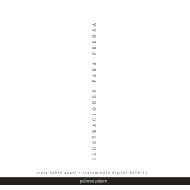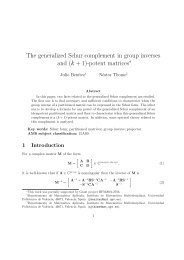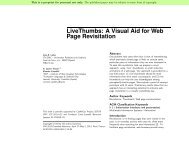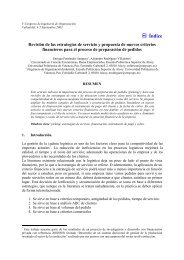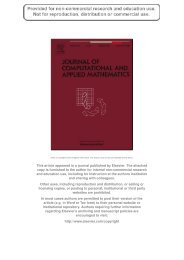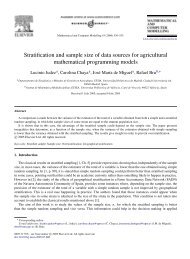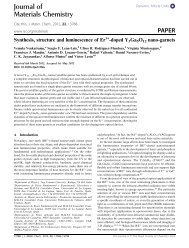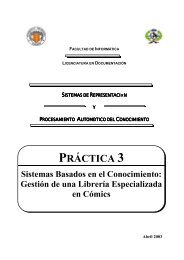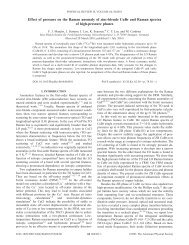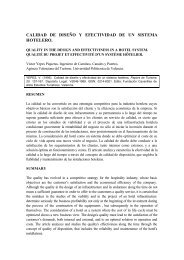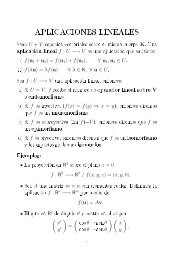Introduction to the resistivity surveying method. The resistivity of ...
Introduction to the resistivity surveying method. The resistivity of ...
Introduction to the resistivity surveying method. The resistivity of ...
You also want an ePaper? Increase the reach of your titles
YUMPU automatically turns print PDFs into web optimized ePapers that Google loves.
41<br />
columns <strong>of</strong> electrodes.<br />
3.3 3-D roll-along techniques<br />
Most commercial 3-D surveys will probably involve grids <strong>of</strong> at least 16 by 16 in order<br />
<strong>to</strong> cover a reasonably large area. A 16 by 16 grid will require 256 electrodes which is more<br />
than that available on many multi-electrode <strong>resistivity</strong> meter systems. One <strong>method</strong> <strong>to</strong> survey<br />
such large grids with a limited number <strong>of</strong> electrodes is <strong>to</strong> extend <strong>the</strong> roll-along technique used<br />
in 2-D surveys <strong>to</strong> 3-D surveys (Dahlin and Berns<strong>to</strong>ne 1997). Figure 30 shows an example <strong>of</strong> a<br />
survey using a multi-electrode <strong>resistivity</strong>-meter system with 50 electrodes <strong>to</strong> survey a 10 by<br />
10 grid. Initially <strong>the</strong> electrodes are arranged in a 10 by 5 grid with <strong>the</strong> longer lines orientated<br />
in <strong>the</strong> x-direction (Figure 31a). Measurements are made primary in <strong>the</strong> x-direction, with some<br />
possible measurements in <strong>the</strong> diagonal directions. Next <strong>the</strong> entire grid is moved in <strong>the</strong> y-<br />
direction so that <strong>the</strong> 10 by 5 grid now covers <strong>the</strong> second half <strong>of</strong> <strong>the</strong> 10 by 10 grid area. <strong>The</strong> 10<br />
by 5 grid <strong>of</strong> electrodes is next orientated in <strong>the</strong> y-direction (Figure 31b).<br />
<strong>The</strong> example data file PIPE3D.DAT was obtained from a survey using such a rollalong<br />
technique. It was carried out with a <strong>resistivity</strong>-meter system with only 25 electrodes,<br />
with <strong>the</strong> electrodes arranged in an 8 by 3 grid. <strong>The</strong> long axis <strong>of</strong> this grid was orientated<br />
perpendicularly <strong>to</strong> two known subsurface pipes. <strong>The</strong> measurements were made using three<br />
such 8 by 3 subgrids so that <strong>the</strong> entire survey covers an 8 by 9 grid. For each 8 by 3 subgrid,<br />
all <strong>the</strong> possible measurements (including a limited number in <strong>the</strong> y-direction) for <strong>the</strong> polepole<br />
array were made. In this survey, <strong>the</strong> second set <strong>of</strong> measurements in <strong>the</strong> y-direction (as in<br />
Figure 31b) was not carried out <strong>to</strong> reduce <strong>the</strong> survey time, and also because <strong>the</strong> pipes have an<br />
almost two-dimensional structure.<br />
For practical reasons, <strong>the</strong> number <strong>of</strong> field measurements in some surveys might be<br />
even less than <strong>the</strong> cross-diagonal technique. Ano<strong>the</strong>r common approach is <strong>to</strong> just make <strong>the</strong><br />
measurements in <strong>the</strong> x- and y- directions only, without <strong>the</strong> diagonal measurements. This is<br />
particularly common if <strong>the</strong> survey is made with a system with a limited number <strong>of</strong><br />
independent electrodes, but a relatively large grid is needed.<br />
In some cases, measurements are made only in one direction. <strong>The</strong> 3-D data set<br />
consists <strong>of</strong> a number <strong>of</strong> parallel 2-D lines. <strong>The</strong> data from each 2-D survey line is initially<br />
inverted independently <strong>to</strong> give 2-D cross-sections. Finally, <strong>the</strong> whole data set is combined<br />
in<strong>to</strong> a 3-D data set and is inverted with RES3DINV <strong>to</strong> give a 3-D picture. While <strong>the</strong> quality <strong>of</strong><br />
<strong>the</strong> 3-D model is expected <strong>to</strong> be poorer than that produced with a complete 3-D survey, such a<br />
“poor man’s” 3-D data set could reveal major <strong>resistivity</strong> variations across <strong>the</strong> survey lines.<br />
Until multi-channel <strong>resistivity</strong> instruments are widely used, this might be <strong>the</strong> most costeffective<br />
solution <strong>to</strong> extract some 3-D information from 2-D surveys.<br />
3.4 3-D forward modeling program<br />
In <strong>the</strong> interpretation <strong>of</strong> data from 2-D <strong>resistivity</strong> imaging surveys, it is assumed that<br />
<strong>the</strong> subsurface geology does not change significantly in <strong>the</strong> direction that is perpendicular <strong>to</strong><br />
<strong>the</strong> survey line. In areas with very complex geology, <strong>the</strong>re are could be significant variations<br />
in <strong>the</strong> subsurface <strong>resistivity</strong> in this direction (i.e. <strong>the</strong> geology is 3-D), which could cause<br />
dis<strong>to</strong>rtions in <strong>the</strong> lower sections <strong>of</strong> <strong>the</strong> 2-D model obtained. Measurements made with <strong>the</strong><br />
larger electrode spacings are not only affected by <strong>the</strong> deeper sections <strong>of</strong> <strong>the</strong> subsurface, <strong>the</strong>y<br />
are also affected by structures at a larger horizontal distance from <strong>the</strong> survey line. This effect<br />
is most pronounced when <strong>the</strong> survey line is placed near a steep contact with <strong>the</strong> line parallel<br />
<strong>to</strong> <strong>the</strong> contact.<br />
Copyright (1999-2001) M.H.Loke



